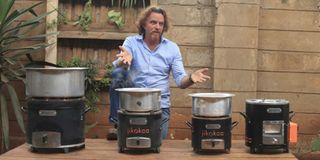Inside the factory that makes your jikos

Peter Scott, founder and chief executive of Burn Manufacturing, which makes Jikokoa, an energy-saving charcoal stove at the company in Ruiru, Kiambu County on August 13, 2020.
What you need to know:
- It takes about 35 seconds for a unit of the product to come out of the production line and so concentration, alertness and speed is a key component in this environment.
- A cocktail of noises from machines banging on metals to form some desired shape, sounds of drill machines making holes to fix a part, falling sheets, clicking and hammer-like sounds play together to form an atmosphere difficult to describe.
- It is here where at least 25,000 clean cooking stoves are manufactured for distribution across Africa every month, 11,000 of the products for the Kenyan market.
Peter Scott hasn’t taken lunch in 10 years. When he eats anything during the day, he does it while walking or doing something else.
“It’s bad manners, I know, but that’s me. I’ve not sat down to have lunch in a decade,” he says.
And when you spend some time with him, he’s not exactly the chief executive officer (CEO) you would have expected, with an expensive, classy suit and a lot of documents on his table. Scott is a different breed of CEO altogether.
Donning a blue shirt (untucked and folded around the arms in no particular fashion), a blue jeans trouser and dusty black shoes, Scott welcomes you to his normal working day at the Burn Manufacturing company in Ruiru, Kiambu county. He is the CEO of Burn — the firm that manufactures Jikokoa cooking stoves, a product that has grown to become a household name across Kenya.
Inside the factory where the jikos are manufactured, tens of workers, mostly young men and women, are lined up in different rows of machines that act as assembly points. Everyone is concentrating on their particular work station, conversing with their partner machine, at least in action and ultimately playing a key role towards the making of a unit of jikokoa.
It takes about 35 seconds for a unit of the product to come out of the production line and so concentration, alertness and speed is a key component in this environment.
A cocktail of noises from machines banging on metals to form some desired shape, sounds of drill machines making holes to fix a part, falling sheets, clicking and hammer-like sounds play together to form an atmosphere difficult to describe.
“The machines are easy to use and so in all the steps, it takes workers very few seconds to complete a process. After every 35 seconds, a Jikokoa comes out of production line,” says Allan Muriithi, the production manager.
It is here where at least 25,000 clean cooking stoves are manufactured for distribution across Africa every month, 11,000 of the products for the Kenyan market.

Peter Scott, founder and chief executive of Burn Manufacturing, set up the plant in Ruiru in his mission to save humanity through environment friendly cookers.
What hundreds of thousands of users and lovers of Jikokoa may never have known is the level of work, research and money that went into the process of coming up with the product. And as Scott said, the purpose of forming Burn Manufacturing was more than a business idea just for its sake. It was a project that would seek to save humanity of deforestation and ridding poor societies across Africa of health hazards that come with using pollutant means of cooking.
“When I was 20 in 1990, I saw deforestation in Congo from charcoal production and I got down to my knees and wept. I told myself I would spend the rest of my life defending the forests of Africa,” Scott said, explaining the beginning of a journey that took more than 20 years to start, but which when it did, there has never been a step backward.
After deciding to take a step towards ending deforestation, Mr Scott became a cookstove designer in 1997, with a key interest in making fuel-efficient stoves. He then worked as a consultant in the industry for 13 years.
In 2010, he brought together a team of some of the best designers and engineers and they retreated for a research that would last for three years at an island in the US, all with the aim of coming up with a cost-effective and fuel-efficient cooking stove that would not only bring deforestation to an end, but also have a positive climatic impact and reduce the burden on health systems among communities that relied heavily on use of charcoal and firewood for cooking.
He knew his market would be Africa and in 2013 after they had designed the stove, he raised about Sh1.5 billion through equity, grants and borrowing, came to Kenya and established the company in Ruiru.





